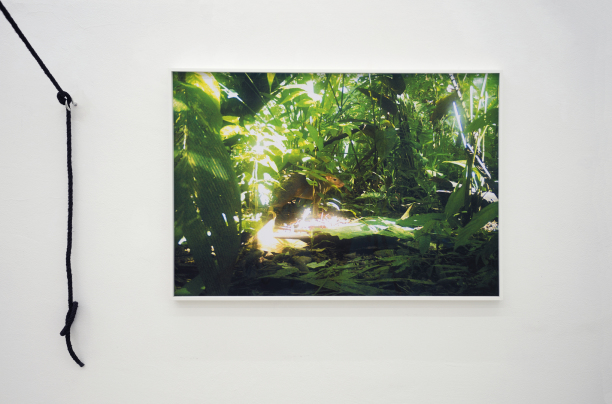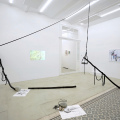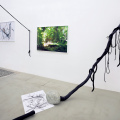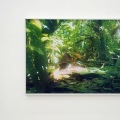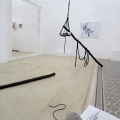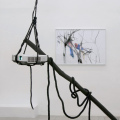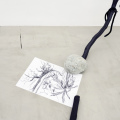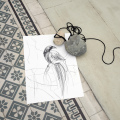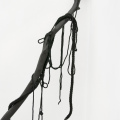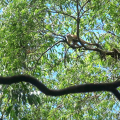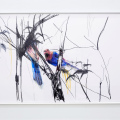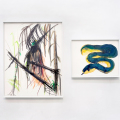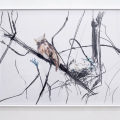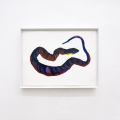18. 9. - 9. 11. 2019
TINA RIBARITS. camera trap
Eröffnung: 17. September 2019, 19.00 Uhr, in Anwesenheit der Künstlerin
Hinweis: Tina Ribarits ist parallel an der Ausstellung "TOUCH WOOD" im Museum Moderner Kunst Kärnten beteiligt. Eröffnung: 18. September 2019
"As they listened, they began to understand the lives of the Forest, apart from themselves, indeed to feel themselves as the strangers where all other things were
at home".
- J. R. R. Tolkien, The Fellowship of the Ring
„camera trap“ ist eine Begegnung mit dem Akt des Sehens; mit dem „Einfangen“ als eine Methode der Auseinandersetzung; mit der Wildnis als Frage, deren Antwort noch lange nichts mit Zivilisation oder Sicherheit zu tun hat. Tina Ribarits bedient sich in dieser Ausstellung analoger sowie digitaler Strategien – Video, Zeichnung und Installation – und vermittelt so das Bild einer poetischen Koexistenz, einen Zustand des Fremdseins an einem Ort abseits des menschlichen Blicks. Man findet eine Dokumentation ohne Notwendigkeit zwingender Genauigkeit vor, ein Echo der Erinnerung, das im Inneren und darüber hinaus nachhallt.
Camera trap is an encounter with the act of looking, with capture as an act of engagement, with the wild as a question whose answer has nothing to do with civilisation or safety. In this show, Tina Ribarits deploys analogue and digital strategies – video, drawing and installation – to collect and convey an experience of poetic-co-existence, an interval of being strange in non-human space. Here we find documentation without the imperative for accuracy, and memory whose lessons continue to recede into a space that is both beyond and within.
Neither the subjects nor the objects of knowledge practices can be taken for granted… one must inquire into the material specificities of the apparatuses that help constitute objects and subjects”.
Karen Barad, Meeting the Universe Halfway
…human actions have mattered decisively, but in quite unpredictable ways…
Dr. K Ullas Karanth, The Way of the Tiger
Das Subjekt löst den Sensor aus, und die Kamera macht eine Aufnahme.
Der Naturschutz-Zoologe K Ullas Karanth ist Pionier im Gebrauch von Kamerafallen, mit deren Hilfe die Populationsdichte des gefährdeten Königstigers untersucht wird. Er ist sich der narrativen Implikationen bewusst, die im Zuge dieser Messungen entstehen. "Beim Zählen der Tiger", sagt er, "erhalten wir ein vollständiges Bild der Gesundheit des Ökosystems. “
Das Subjekt einer Kamerafalle ist nie alleine.
Die Apparate für das Beobachten, Testen, Studieren und Beurteilen sind niemals objektiv; selbst unter der klinischen Kontrolle wissenschaftlicher Methoden hinterlässt unser Beobachten eine Wirkung, und diese Wirkung ist gegenseitig. Und was untersucht wird, ist viel mehr als zunächst vermutet, wenn wir uns die Interferenzen, Beziehungen und Geschöpfe ansehen, die scheinbar leere Räume bevölkern.
Wie uns auch Donna Haraway daran erinnert, dass wir Erdbewohner niemals alleine sind.
Mach ein Foto und zähle die Verbindungen. Mit "Nehmen" (Anm.: „Take a picture“ im engl. Originaltext) meine ich hier "Betrachten/Überlegen". Die Kamerafalle erfasst, ohne behalten zu wollen. Ist das eine Bilderzeugung ohne Objekterzeugung? Eine Technik der Konservierung statt der Ausbeutung?
***
Tina Ribarits´ Werke bedienen sich grosszügig dem leeren Raum. Dem ist eine nicht quantifzierbare Tiefe eigen (und, vielleicht noch wichtiger, eine nicht qualifizierbare Tiefe), mit Lücken in der realen Materie, wo sich der eigentlich größte Teil des Universums befindet, wie uns die Quantenphysik versichert. Berücksichtigt man die Lebewesen im Zentrum dieser Arbeit, eröffnet sich Raum für sehr viel mehr.
Zum Beispiel die Eule und ihre Jungen. Dieses Bild bietet keine Details, die unseren Blick in Raum und Zeit verankern würde. Der horizontlose Himmel könnte mitteleuropäisch, winterweiß oder feucht-dunstig sein, ein bewölkter Morgen oder ein verregneter Nachmittag. Die schwarzen Linien erinnern an kahle Birkenzweige, aber die blauen Unterbrechungen lassen mich Anderes vermuten. Der Sitz-Ast der Eule wirkt architektonisch. Die Eulen-Jungen könnten ein Hinweis auf die Jahreszeit geben, aber Jahreszeiten waren immer nur eine Annäherung und verlieren angesichts der globalen Erderwärmung noch mehr an Bedeutung. Ihre kleinen Körper verschmelzen mit dem Hintergrund, fast blass und ausdruckslos im Vergleich zum detailliert gezeichneten finsteren Blick der Eule, ihrem dunklen Antlitz und dem braun gefleckten Körper. Die Augen der Jungvögel sind der klarste Hinweis, dass sie existieren.
Oder die Schlange. Eine Aquarellschlange kann viel länger sein, als sie zunächst scheint. Die Größe des Kopfes ist ein Anhaltspunkt, aber wir können die Windungen nicht zählen, keine Vermutung über die Länge von Zunge bis Schwanzende wagen. Ihr Körper scheint direkt dem Farbkreis eines Schulkindes entsprungen: Gelb-und-Blau-macht-Grün. Es ist ein Widerstreben gegen das Ornamentale, eine Ablehnung der Logik des exotisierenden Blicks, der sich beharrlich in den Mittelpunkt stellt – dem Nullpunkt, von dem gesehen alles andere mehr oder weniger seltsam zu wirken beginnt.
Alles in allem laden uns die Arbeiten dieser Ausstellung in einen Zustand des Miteinander-Seins ein. camera trap zeigt das rhizomatische Gewirr der Wildnis, während gleichzeitig das „Entdecken“ von „Eroberung“, das „Fangen“ von „Gefangenschaft“ entkoppelt wird. In dieser Einzelausstellung verwendet Ribarits Video, Zeichnung und Installation, um dem Betrachter Eindrücke, Phänomene und Bilder aus nicht-menschlichem Terrain zu bieten, einer Wildnis, in der sich das Auge der „Zivilisation“ eigen ausnimmt. Es ist verortet, präsent, und tut das, was Augen tun (anatomisch, artifiziell, erfinderisch): Sammeln, erinnern, erdenken.
- Season Butler, 2019
The subject trips a trigger and the camera captures an image.
Conservation zoologist K Ullas Karanth pioneered the use of camera traps to study population densities of endangered Bengal tigers, and is mindful of the narrative implications that surround the arithmetical ones; ‘by counting tigers,’ he tells us, ‘we are getting a complete picture of the health of the ecosystem.’
The subject of the camera trap is never alone.
The apparatuses of seeing, testing, studying, auditing are never objective; even under the clinical control of scientific methods, our looking leaves an impression and the impression is mutual. And what is accounted for offers a view of much more than the image first suggests when we look into the inferences, the relations, the critters populating apparently empty spaces.
As Donna Haraway reminds us, none of us earthlings are ever alone.
Take a picture and count the connections.
By ‘take’ here, I mean ‘consider.’ The camera trap captures without seeking to keep. Is this image-making without object-making? A technology of conservation, not extraction?
***
Tina Ribarits’ work is generous with empty space, with unquantified depth (and, perhaps even more importantly, unqualified depth), with gaps in the apparently material which, as quantum physics assures us, is where most of the universe actually resides. Taking account of the critters at the centre of this work opens space to account for so much else.
Take the owl and her owlets. This image resists detail that might anchor our looking into space and time. The horizonless sky could be central European, winter-white, or indistinct and dim with humidity, cloudy morning or dog day afternoon. The black lines could be bare birch branches, but the interruptions of blue won’t let me think so. The owl’s perch looks architectural. The owlets might once have been a clue to seasonality, but seasonality itself was only ever an approximation and maps even less reliably in the carbon age. Their little bodies almost merge with the background, nearly as pale and featureless compared to the owl’s detailed scowl, dark face and brown mottled body. Their eyes are the clearest clue to the fact of their existence.
Or take the snake. A watercolour snake may be much longer than it first appears. The size of its head is one clue, but we can’t count the coils, can’t hazard a guess at the length from tongue to tail. Its body is a slice out of the school-child’s colour-wheel: yellow-plus-bluemakes-green. There is a certain resistance to ornamentation here, a refusal of the logic of the exoticising gaze which always places itself at the centre, the zero point from which all else can be more or less strange. Taken together, the work in this exhibition invites us into a state of being-with. camera trap depicts the rhizomatic tangle of the wild, while also decoupling discovery from conquest, capture from captivity. In this solo show, Ribarits uses video, drawing and installation to offer the viewer impressions, phenomena and imagery from non-human terrain, a wilderness where the eye of ‘civilisation’ is rendered strange. It is situated, present, doing what eyes do (anatomical, artificial, imaginative): collecting, recalling, envisioning.
- Season Butler, 2019
CURRENT / UPCOMING:
Gumpendorfer Strasse 53
A-1060 Wien / Austria
office[a]agnesreinthaler.com
Sign up for the gallery newsletter
Please note that we are not accepting unsolicited artist submissions.
UID: ATU66256008
FN 357375b
.

